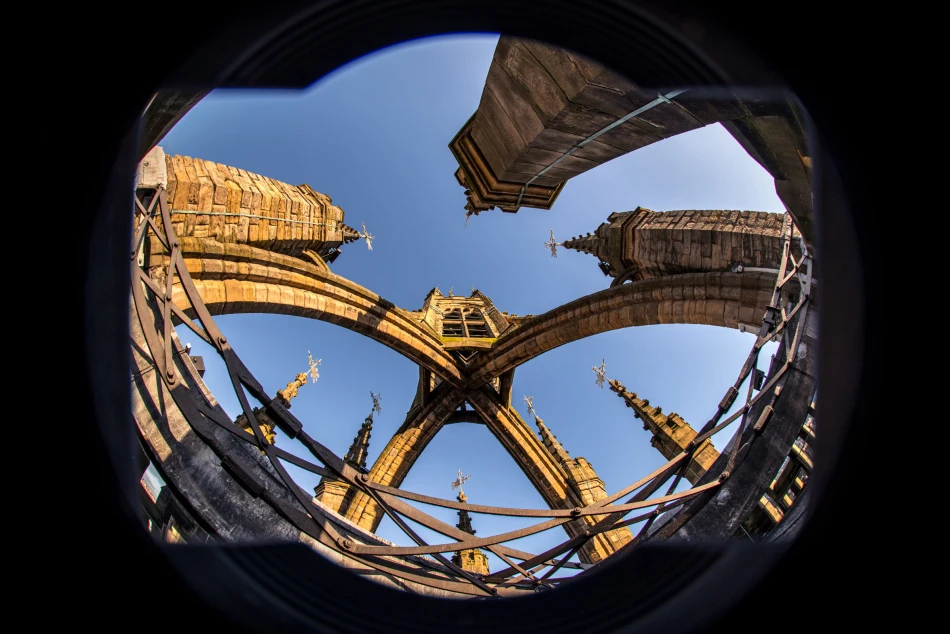
In a city close to bursting with remarkable historical locations and interesting buildings, Newcastle Cathedral is one of the most notable. Right in the heart of the city, this stunning landmark is so much a part of Newcastle life that it’s perhaps easy to take it for granted, so we decided to take a look behind the big wooden doors.

Much of the cathedral’s history is tied up with the castle of course, and the original church seems to owe its existence to Bishop Osmond of Salisbury who commanded a church be built next to the castle which was there to keep out marauding Scots. This simple wooden affair was replaced by a stone church at the end of the 12th century after a fire, and it is this that became the St Nicholas Church that stands (in a very different form) today. In fact, a tiny amount of the original stone structure remains if you look at the south-west pillar’s stonework. Appropriately enough, the church was dedicated to St Nicholas and his image is visible all over the church in its carvings and windows. There were probably further fires and renovations until the 14th century when the church began to attain the grandeur with which it is now associated.
The church has been added to and expanded in the intervening seven centuries, with significant additions in the eighteenth century such as the transept, north and south porches and the Thomlinson Library, while the last century saw the addition of the Cathedral Hall. Perhaps the most distinctive feature is the 60 metre, three storey Lantern Tower - one of the city’s most significant landmarks - which dates to the 15th century and was possibly gifted by Robert Rhodes. The tower’s fourteen bells have marked every quarter-hour for centuries and the oldest bell is at least six centuries old, while the newest – the Millenium Bell – dates from 1999. The tower was described in 1847 as ‘one of the noblest and most admired structures that adorn our island. It exhibits originality, boldness and magnificence which render it an architectural prodigy.’

The centuries since have seen countless changes to the church - whether through improvements, conflict, theft or vandalism - and it grew in stature and grandeur. The font alone has its own fascinating history: when the Scottish army conquered the town in 1640 and destroyed the font in St John’s Church, a local mason named Cuthbert Maxwell dismantled and hid the parts of the font until 1660, when he felt it was safe to rebuild it on its present spot. Every part of the Cathedral is similarly rich in history – of both the building itself and the people of the city recognised in its walls, ledgerstones and windows – and the it's a fascinating place to lose yourself, armed with the bountiful guides and displays available to lay it all out. The memorials, chapels, the churchyard, The Crypt and passageways and even the organ have their own stories waiting for you to discover them.

It wasn’t until 1882, when Newcastle was conferred city status by Queen Victoria’s Royal Charter, that St Nicholas finally attained cathedral status. Various changes were made to the building at the time but after that flurry of activity, there weren’t many opportunities to make changes or properly preserve what was there and by the end of the 20th century the Cathedral was in dire need of repairs and improvements – its very infrastructure was badly in need of work. A Heritage Lottery Fund Grant in 2017 arrived just in time and a series of major works was able to take place, wrapping up in 2021 and leaving the Cathedral in the remarkable condition we now find it. Pews were removed, stonework was cleaned and lighting and heating were added. The Cathedral now manages to incorporate both its incredible history and a newfound sense of modernity and vibrancy. One of the most recent and certainly most striking developments is the new liturgical furniture, created by local designers RASKL. Inspired by the local industries and technology that made the North East what it is, and intended to complement the medieval font, the altar reflects the city’s shipbuilding tradition while the ambo (or elevated pulpit) reflects the mining history of the area. There’s even a soundwave rendered in three dimensions, using the opening notes of the Cathedral choir singing ‘O Lord, open thou our lips and our mouths shall show forth thy praise.’

Of course, the Cathedral is not merely a museum or site of historic interest: it is a living, breathing part of the city’s spiritual and civic life. As well as the services, there are concerts, exhibitions, workshops, volunteering opportunities and much more for you to get involved in.
Newcastle Cathedral is one of the city’s key landmarks – literally and figuratively – and any time spent there, whether in worship or simply through curiosity about its rich history, is time very well spent. We recommend paying a visit to a building that you might have walked past for so many years that you barely even notice how magnificent it is.

Photography courtesy of: Michael Baister Photography (external view), Nicholas Farka, Red and Round Photography (the font) and Andrew Perkins/Jigsaw Design & Publishing (all other images).



